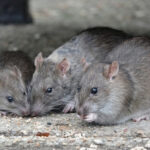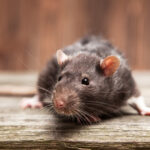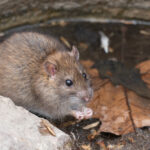How Can We Help?
What are some common rat nesting materials and locations?
Rats like to use all sorts of materials to build their nests, usually picking things that are easy to find and provide comfort and warmth. Comm5on nesting stuff includes shredded paper, cardboard, fabric, insulation, and soft items  like cotton and plant matter. Rats are pretty resourceful, so they'll use almost anything they can chew and shape into a cozy nest. These materials help keep the nest warm and provide a safe spot for their young.
like cotton and plant matter. Rats are pretty resourceful, so they'll use almost anything they can chew and shape into a cozy nest. These materials help keep the nest warm and provide a safe spot for their young.
Rats pick nesting spots based on safety, access to water and food, and protection from the elements and predators. Indoors, they often nest in wall cavities, attics, basements, crawl spaces, and behind appliances. They might also nest in stored items like boxes, clothing, or furniture, especially in cluttered areas that offer good hiding spots. In homes, they tend to nest in or near kitchens and pantries where food is easy to find.
Outside, rats usually burrow into the ground for their nests, especially in overgrown areas, under dense vegetation, or beneath structures like sheds and decks. They might also use compost heaps, woodpiles, and garbage areas as nesting sites. These spots provide the cover and materials they need to stay hidden.
Do rats build separate nests for sleeping, food storage, and raising young?
Rats usually don't bother building separate nests for sleeping, food storage, and raising their young; instead, they use one nest for everything. This nest acts as their main hub, providing a safe space for resting, raising their babies, and sometimes storing food. They prioritise keeping their nests safe and hidden, choosing spots that offer protection from predators and are close to food and water.
In the nest, rats sleep and raise their young, making sure the babies are well-protected and cared for. Female rats, in particular, are attentive mothers, looking after their pups until they're ready to fend for themselves. While the main nest serves many purposes, rats might set up multiple nesting sites within their territory as backups or to accommodate a growing population.
Even though they don't usually have separate nests just for food storage, rats often hoard food near or in their nests. They carry food items back to their nest to eat in relative safety. This helps them survive when foraging is risky or food is scarce.
How do rats protect and defend their nests from predators or other threats?
Rats use various tricks to keep their nests safe from predators and other threats, relying on their sharp senses, agility, and social behaviors. One key defense is picking well-hidden nesting spots that are tough for predators to reach. They often choose places that are hidden and have multiple escape routes.
Rats are super alert and use their keen sense of smell, hearing, and touch to spot potential threats. When they sense danger, they quickly retreat to their nests. Their ability to navigate tight spaces and move quickly helps them dodge predators effectively. Plus, rats often create multiple entry and exit points in their burrows or nesting sites, giving them alternative escape routes if one is compromised.
danger, they quickly retreat to their nests. Their ability to navigate tight spaces and move quickly helps them dodge predators effectively. Plus, rats often create multiple entry and exit points in their burrows or nesting sites, giving them alternative escape routes if one is compromised.
Social behavior is also key in the next defense. Rats communicate with each other through vocalizations, pheromones, and body language to warn the colony of approaching danger. This communication network ensures that the whole colony can respond quickly to threats. When faced with an intruder, rats may show aggressive behaviors like biting and scratching to defend their territory and protect their young.
To boost nest security further, rats regularly move their nests if they sense a persistent threat, making sure predators and other dangers don't get too familiar with their location. These adaptive behaviors help rats protect their nests and keep their colonies safe and stable.
What are some signs that a rat nest may be present in a particular location?
Several signs can hint at a rat nest in a certain area, and knowing these can help in spotting and controlling a rat infestation early on. One of the most obvious indications is rat droppings, usually found near food, entry points, and nesting spots. These droppings are small, dark, and pellet-shaped. Another sign is gnaw marks on things like wires, wood, plastic, and food packages, as rats need to gnaw constantly to keep their teeth sharp.
You might also come across nesting materials like shredded paper, fabric, insulation, or plant matter in hidden spots, as rats use these to build their nests. Unusual sounds like scratching, scurrying, or squeaking, especially at night, can point to active rats moving within walls, ceilings, or attics. Grease marks or smudges along walls and baseboards are another clue, as rats leave oily residue from their fur when they travel along their usual routes.
 Rat burrows or holes near the foundation of buildings, in gardens, or under debris and vegetation can also signal an active nesting site. Plus, a strong, musky odor often accompanies a rat infestation, especially if the nest is well-established. Finding chewed-up food or small food stashes hidden in odd places can also indicate a nearby nest.
Rat burrows or holes near the foundation of buildings, in gardens, or under debris and vegetation can also signal an active nesting site. Plus, a strong, musky odor often accompanies a rat infestation, especially if the nest is well-established. Finding chewed-up food or small food stashes hidden in odd places can also indicate a nearby nest.
Spotting these signs is key to taking quick action to find and get rid of rat nests, preventing the infestation from growing and causing more damage or health risks. Hiring a professional pest control service like ours here at Youngs Pest Control can help identify and eliminate any rat nests in and around your property effectively. So, if you notice any of these signs, it's best to act fast before the rat colony gets too comfortable and difficult to control.
